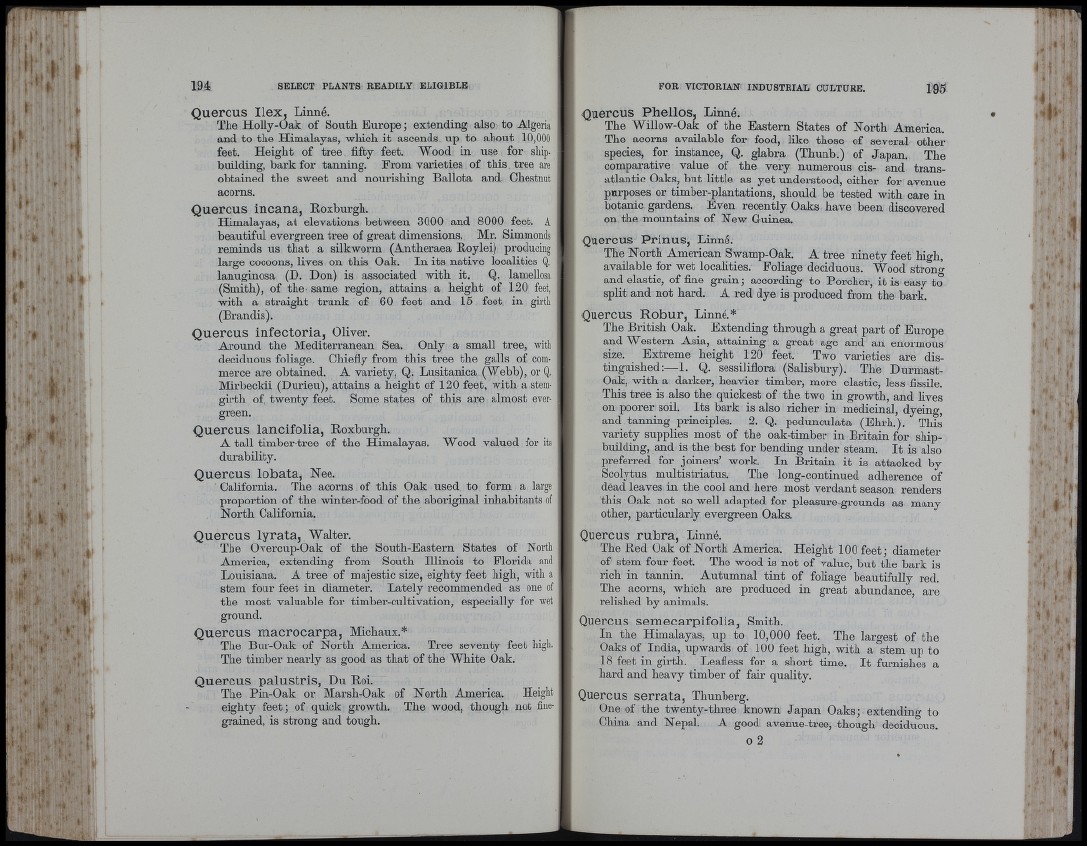
' 5. "<
Quercus Ilex, Linné.
The Holly-Oak of South Europe; extending also to Algeria
and to the Himalayas, which it ascends up to about 10,000
feet. Height of tree fifty feet. Wood in use for shipbuilding,
bark for tanning. Erom varieties of th is. tree are
obtained the sweet and nourishing Ballota and Chestnut
acorns.
Quercus incana, Roxburgh.
Himalayas, at elevations between 3000 and 8000 feet. A
beautiful evergreen tree of great dimensions. Mr. Simmonds
reminds us that a silkworm (Antheraea Roy lei) producing
large cocoons, lives on this Oak. In its native localities Q.
lanuginosa (D. Don) is associated with it. Q. lamellosa
(Smith), of the same region, attains a height of 120 feet,
with a straight trunk of 60 feet and 15 feet in girtli
(Brandis).
Quercus infectoria, Oliver.
Around the Mediterranean Sea. Only a small tree, witli
deciduous foliage. Chiefly from this tree the galls of commerce
are obtained. A variety, Q. Lusitanica (Webb), or Q,
Mirbeckii (Durieu), attains a height of 120 feet, with a stem-
girth of. twenty feet. Some states of this are almost evergreen.
Quercus lancifolia, Roxburgh.
A tall timber-tree of the Himalayas. Wood valued for its
durability.
Quercus lobata, Nee.
California. The acorns of tbis Oak used to form a large
proportion of the winter-food of the aboriginal inhabitants of
North California.
Quercus lyrata, Walter.
The Overcup-Oak of the South-Eastern States of Nortli
America, extending from South Illinois to Florida and
Louisiana. A tree of majestic size, eighty feet high, witli a
stem four feet in diameter. Lately recommended as one of
the most valuable for timber-cultivation, especially for wet
ground.
Quercus macrocarpa, Michaux.*
The Bur-Oak of North America. Tree seventy feet liigb.
The timber nearly as good as that of tbe White Oak.
Quercus palustris, Du Roi.
The Pin-Oak or Marsh-Oak of North America. HeigM
eighty feet; of quick growth. The wood, though not finegrained,
is strong and tough.
Quercus Phellos, Linné.
The Willow-Oak of the Eastern States of North America.
The acorns available for food, like those of several other
species, for instance, Q. glabra (Thunb.) of Japan. Tbe
comparative value of the very numerous cis- and transatlantic
Oaks, but little as yet understood, either for avenue
purposes or timber-plantations, should be tested with care in
botanic gardens. Even recently Oaks have been discovered
on the mountains of New Gruinea.
Quercus Prinus, Linné.
The North American Swamp-Oak. A tree ninety feet high.
available for wet localities. Foliage deciduous. Wood stron»
and elastic, of fine grain; according to Porcher, it is easy to
split and not bard. A red dye is produced from the bark.
Quercus Robur, Linné.*
The British Oak. Extending through a great part of Europe
and Western Asia, attaining a great age and an enormous
size. ^ Extreme height 120 feet. Two varieties are distinguished:—
1. Q. sessiliflora (Salisbury). The Durmast-
Oak, with a darker, heavier timber, more elastic, less fissile.
This tree is also the quickest of the two in growth, and lives
on poorer soil. Its bark is also richer in medicinal, dyeing,
and tanning principles. 2 . Q. pedunculata (Ehrh.). This
variety supplies most of the oak-timber in Britain for shipbuilding,
and is tbe best for bending under steam. I t is also
preferred for joiners’ work. In Britain it is attacked by
Scolytus multistriatus. The long-continued adherence of
dead leaves in the cool and here most verdant season renders
this Oak not so well adapted for pleasure-grounds as many
other, particularly evergreen Oaks.
Quercus rubra, Linné.
The Red Oak of North America. Height 100 feet; diameter
of stem four feet. The wood is not of value, but tbe bark is
rich in tannin. Autumnal tin t of foliage beautifully red.
The acorns, which are produced in great abundance, are
relished by animals.
Quercus semecarpifolia. Smith.
In the Himalayas, up to 10,000 feet. The largest of the
Oaks of India, upwards of 100 feet high, with a stem up to
18 feet in girth. Leafless for a short time. I t furnishes a
hard and heavy timber of fair quality.
Quercus serrata, Thunberg.
One of the twenty-three known Japan Oaks; extending to
China and Nepal. A good avenue-tree, though deciduous.
o 2